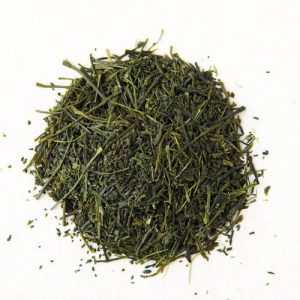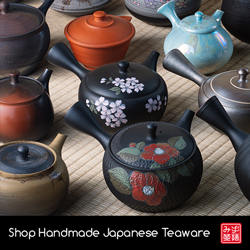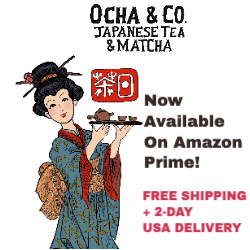 Sencha (煎茶, literally translates as decocted tea) is the most popular type of green tea in Japan. In fact, more than 80% of the green tea processed in Japan results in sencha.
Sencha (煎茶, literally translates as decocted tea) is the most popular type of green tea in Japan. In fact, more than 80% of the green tea processed in Japan results in sencha.
When brewed, this tea has a greenish golden color, a refreshing aroma and a good balance between astringency and sweetness.
How is sencha made?
All types of tea come from the Camellia Sinensis plant. The difference between different teas lies in the cultivation and further processing. Sencha is made from green tea leaves that are cultivated in direct sunlight (as opposed to matcha and gyokuro), and are harvested in the first or second flush (tea leaves of the first harvest have the best quality).
The leaves of the upper shoots (which are younger) are used because they are of higher quality than those of the lower shoots.
Once the tea leaves have been picked, they are steamed to prevent oxidation. This process lasts less than a minute but is the most important step and is the main difference between Japanese and Chinese green tea (which is pan-fried instead of steamed).
Next, the leaves are dried and rolled. When rolled, the leaves attain the familiar needle shape and as a bonus the juices inside the leaves are released by this action, so that the taste is intensified.
I’ve added a video where the steaming, drying and rolling is made at a sencha processing plant:
How to brew sencha
For best results, use a Japanese teapot (kyusu: 急須). Note that the teapot is not to be heated directly. Use a tea kettle instead and heat the water just before the boiling point. Pour the water from the tea kettle into the number of cups that you will serve. This way the water’s temperature drops and you get a good measure of liquid for your servings. Each cup should have 60 ml of water.
Next, add the sencha to the teapot. A general rule of thumb is to use one teaspoon of sencha (4 grams) per cup. Pour the water from each cup into the teapot and let brew for 1 minute. The temperature for brewing sencha should be around 70 ºC (158 ºF), 80 ºC (176ºF) is also fine.
The final step is to serve the tea in each cup. Don’t fill each cup one after another, try to fill each cup little by little so that the tea is evenly distributed. The remaining tea in the teapot is more concentrated. Pour until the last drop.
The following video is in Japanese, but you can follow the steps easily:






January 29, 2014
Fascinante el pequeño servicio, los armónicos movimientos de las manos de la joven me han dejado sin aliento…
(Translation) Fascinating, the small service and harmonic movements of the young lady’s hands have left me speechless…
June 3, 2015
Thanks for the informative article! Now I can brew tea and distribute them equally! Didn’t know this was the way to do it….. If you think about it, it’s really common sense but I guess I didn’t care enough to realise it….
June 3, 2015
Hi Kajong
Yes, to distribute tea you can either use the Japanese traditional way of “mawashi sosogi” which is alternating from cup to cup, or the Chinese concept of the “fairness cup” where you serve the entire content of the teapot into another vessel so that it is completely mixed before serving.
June 3, 2015
Hi Ricardo,
Thank you for your immediate response! Yes I forgot about the Chinese method – I saw the shopkeeper of a Chinese tea shop demonstrate it and for some reason, didn’t realize why she was doing it. Most likely due to my boredom…. (I was accompanying my parents and was bored stiff)
Good to know I can have my tea nicely mixed now! 😀
Keep up the good work! I can feel that you are genuinely passionate about Japanese tea.
May 24, 2016
can I brew shincha using the same procedure as sencha?
May 24, 2016
Hi Dee
I guess I should write a post about this as well. I’ve seen some Japanese tea companies suggesting 1 tsp per person, 60 ml water at 70-80 degrees Celsius, but only 40 seconds steeping.
Other times, it’s brewed like a gyokuro.
June 12, 2016
Hello, thank you for this awesome page!
I wanted to ask you about the subsequent brewing of Sencha.
Could you write some guidelines on water temperature and steeping time for the second and third infusion?
Also, how is it with other types of tea like Houjicha or Gyokuro?
Thank you for your time!
Best wishes, J.
June 21, 2016
Hello Jernej
Sorry for the late reply.
There aren’t set guidelines for re-steepings, here is more info on the subject: https://www.myjapanesegreentea.com/re-steeping-japanese-green-tea
March 25, 2017
are there any health benefits to drinking sencha green tea
March 25, 2017
Hi Flo
All green teas have the same health benefits in general. It’s not that one works for something and another works for something else.
The difference is in flavor and aroma.
July 15, 2018
Hi Ricardo
where do I buy Japanese Sencha? Could you share the product detail page for the same?
July 16, 2018
Hi Aditya, thanks for commenting.
It’s hard for me to tell you about a single place because I review teas from many tea stores. Take a look at the reviews, or maybe even the sidebar on this page where I have ads from the vendors.
November 15, 2020
Hi,
I’m hopeful that you still look at these pages but I won’t be too surprised not to hear back.
My friend and I just had a disagreement because I mixed two different types of her Japanese green teas against her permission and she was very upset about this. I’m wondering, are there any articles out there that you know about that talk about the spiritual or ceremonial significance of the different tea types, and how I can attempt to understand why this is looked down upon? She thinks I’m disrespecting her tea knowledge by mixing my own blends without knowing the ritual significance of the different teas which I believe I’d just like to have some resources to help understand her feelings.
Anything you can offer is most appreciated!
Hope your still finding time to share your passion about tea.. It’s tremendous!
Thx,
-Freshly boiled
November 16, 2020
Thank you for your question.
I wouldn’t be happy if someone mixed two types of my green teas either : )
Not because of any spiritual significance, but because that would be like mixing two good wines and then having one that may not be as good.
It’s possible to make a blend and get something better, yes, but that requires knowledge and experience. If it was a high quality tea blended with a lower quality tea, then the high quality one was most likely ruined.
I do like to practice mindfulness with tea every once in a while, but I’m not a practitioner of the tea ceremony. Although I find it very interesting.
You can fully appreciate tea without practicing the tea ceremony. Again, we can compare it to wine, supposing that there was a wine ceremony. I’m mainly interested in appearance, aroma, and the flavor of tea.